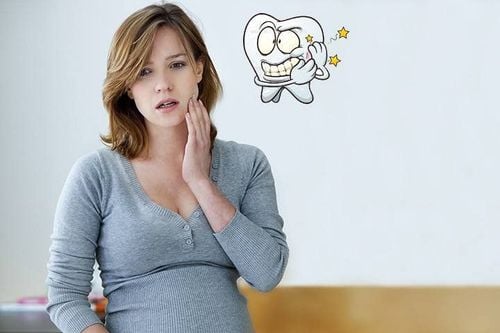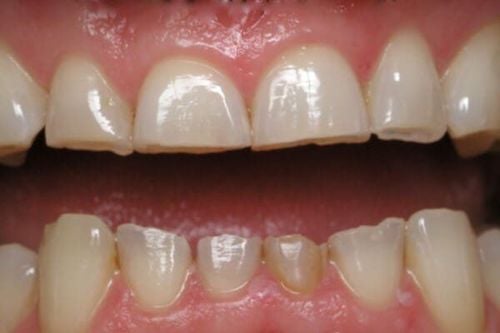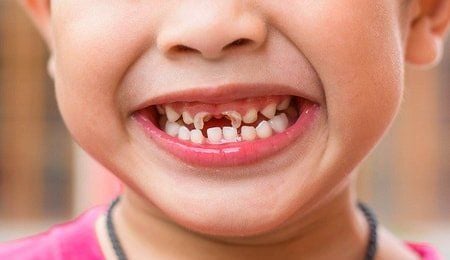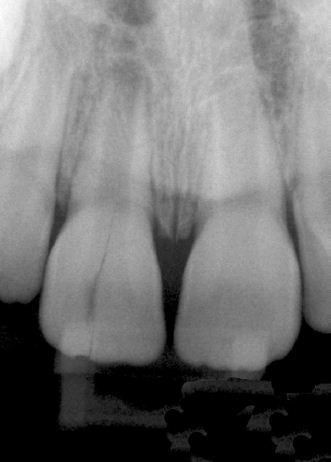This is an automatically translated article.
Cracked teeth are common and the leading cause of tooth loss. Chewing hard foods, grinding teeth at night and even natural occurrences as the body ages... are all reasons for cracked, worn out teeth. Fillings to treat cracked, broken, worn teeth is a treatment method that many people are interested in.
1. Causes of cracked teeth, broken teeth, worn teeth
Teeth are cracked, broken and worn due to a variety of problems, including:
Pressure from teeth grinding ; Previous fillings were too large, leading to impaired integrity of the teeth; Chewing or biting hard foods (ice, nuts, or hard candy); Punches to the mouth, car accidents, sports injuries, falls...; Sudden changes in temperature in the mouth such as eating something very hot and then lowering the temperature suddenly with ice; Due to age, most tooth cracks and fractures occur in people over the age of 50.
Trắc nghiệm: Thử hiểu biết của bạn về răng
Răng là bộ phận quan trọng, giúp một người sử dụng miệng để ăn, nói, cười và tạo hình dạng cho khuôn mặt của họ. Tuy nhiên, có những sự thật thú vị về răng mà có thể bạn chưa từng biết. Hãy cùng trả lời nhanh 9 câu hỏi trắc nghiệm sau để thử hiểu biết của bạn về răng.
Bài dịch từ: webmd.com
2. Symptoms of cracked teeth
When left untreated, cracked, broken or worn teeth can lead to pain and discomfort. Cracked or worn teeth don't necessarily cause any symptoms, and many people have cracked teeth without even realizing it. Clinically, some fissures are harmless and do not require treatment. However, if the patient notices the following symptoms, you most likely have a large crack or broken tooth and need dental treatment:
Pain when eating, especially pain when chewing or biting; Swollen gums around cracked teeth; Teeth sensitive to sweetness; Teeth sensitive to heat or cold; More frequent pain, Discomfort around teeth and gums.

3. Types of tooth cracks
Cracked teeth are common in people over 40 years old, women more often than men. Dental cracks can vary in length, depth, and location on the tooth. The smallest cracks are called fissures, and they develop inside the enamel. The following are the types of dental cracks:
Oblique superficial cracks: These only affect the crown of the tooth and do not extend below the gum line. Therefore, this form of tooth fracture is usually not very painful. Oblique fissures: These extend below the gum line and can be painful. Treatment is essential to expose the crown and restore the tooth. Split tooth: A crack that splits the tooth in half. The dentist can only save part of the tooth, which may require root canal treatment. Oblique root fissures: These cracks usually do not appear on the surface of the tooth, but damage occurs below the gum line, most commonly below the jawbone. Extraction is the only treatment for oblique root fissures. Mastoid fractures occur when the chewing surface of a tooth breaks. The most common crack is located around the filling. Longitudinal apical fissure: crack that begins at the root and extends towards the crown, cracks of varying lengths, but usually requires removal of the tooth as this type of fracture causes great pain.
4. Treatment options for cracked teeth, broken teeth, worn teeth
Dentists can use a specialized material to fill teeth in places that are cracked, broken, worn. The specific treatment depends on the location of the crack/break and the extent of the damage. If the crack is small and causing no discomfort, no treatment may be needed. Treatment of cracked teeth, broken teeth, worn teeth includes:
Filling in the part of the tooth that is chipped or broken; Repair cracks in flexible plastic; Porcelain veneers In the most severe cases, when the crack has penetrated the pulp, root canal treatment is necessary. If the tooth is severely cracked, the dentist may remove it completely. If the filling is cracked, the dentist may need to remove the filling to examine the tooth for damage more thoroughly. Cracked teeth can cause complications, especially if not treated in time, it can lead to infection with signs including:
Severe pain; Swollen gums; Increased sensitivity to heat and cold; Bad breath ; Neck pain. If there is an infection, there is pus, which may require drainage and antibiotics.
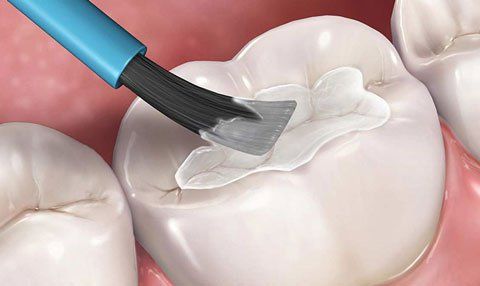
5. Steps of filling teeth
Fillings are applied to repair cracked, broken or worn teeth. The first step to take when filling a tooth is to numb the area of the tooth that needs filling. Next, a drill, air abrasive, or laser will be used to remove the damaged area. The choice of appliance depends on each dentist's experience, specific expertise and equipment, as well as the location and extent of tooth decay.
Next, the dentist will probe or examine the damaged tooth area to determine if all stains have been removed. The dentist will then prepare the space for the filling to be placed in. If the crack is near the root of the tooth, your dentist will place a lining to protect the nerve.
The filling materials will be placed in the required position layer by layer. Next, a special light is shined on the tooth to harden each layer of material that has been applied. When the process is complete, the dentist will shape the material to the desired result, remove excess material, and polish the restoration one final time.
6. How to prevent cracked teeth, tooth wear
Cracked teeth and worn out teeth are not always preventable, but some helpful measures can minimize this risk, including:
Limit hard, difficult foods to chew like ice cubes and seedless popcorn; Change bad habits that can wear down your teeth, such as grinding your teeth or biting a pen; Try not to grind your teeth; Using mouth guards when playing sports; Talk to your doctor about wearing a mouth guard at night, especially if you grind your teeth or clench your jaw while sleeping. The Dentistry - Jaw - Facial Department of Vinmec International General Hospital specializes in the treatment of intensive pathology and aesthetics on the entire tooth structure (teeth, bone, pulp,...), jaw ( palate, jaw, jaw joints,...) and face (frontal bone, cheekbone, temporal bone,...). Therefore, when having any problems with their teeth, customers can directly contact the hospital for examination and timely treatment indications from a specialist doctor.
Please dial HOTLINE for more information or register for an appointment HERE. Download MyVinmec app to make appointments faster and to manage your bookings easily.
References: healthline, webmd




